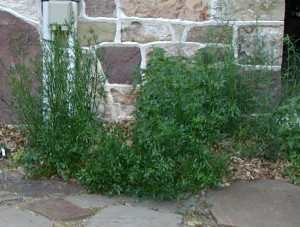This spring has really got the herbs growing strong. Good temperatures and rain at the right times has helped them reach new heights. We’ve been surprised at just how quickly a few herbs had grown this early Spring.
The fast-growing herbs were the biennial parsley and perennial tarragon and catnip. These particular herbs were growing right next to the house, within five feet of the stone structure that faces south. The stone walls collect heat as the sun shines during the day. At night they release this stored energy and that boosted the growth of these herbaceous plants. On the side of the herb bed opposite the house is a flagstone walkway, so those large flat stones also hold and release heat that benefits plant growth.
Parsley that was planted last year overwintered and started re-growing early. These flat-leaf parsley plants reached about three feet tall and started putting energy into making their seed heads. Each plant was pulled up, roots and all. Dirt was shaken from the roots and the plants were hung upside down to dry.

Catnip was treated the same way, so the entire plant was pulled up and hung to dry. We know there are mother roots that have been established under the flagstone walkway, so the catnip plants that were pulled up will be replaced by others.
The tarragon was pulled up by the roots like the other herbs that were harvested, but instead the Russian tarragon was put in the compost pile. We’ve used it in a few dishes and never appreciated any flavor from the Russian variety. Right next to that we have a French tarragon plant. I only wish that the French tarragon would have grown so well. It’s such a scraggly little plant compared to the Russian one. Perhaps with the large plants out of the area, the French tarragon will now take off. It has such a pleasing scent and anise-like flavor.
May 11 has to be the earliest that we’ve harvested this amount of herbs. Soon, we’ll have to harvest some thyme, mints and oregano so that we get the most flavorful herbs before they go to seed.
